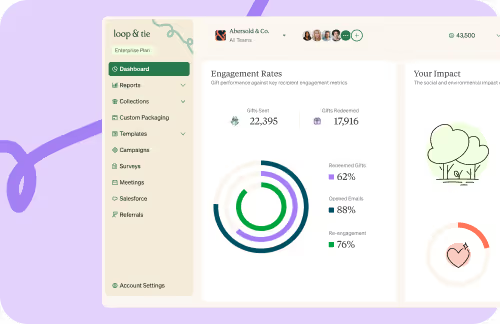Guide to Building an Effective Employee Appreciation Programs
Discover the key elements to consider when designing an impactful employee appreciation program that boosts morale and productivity.
Understanding the Importance of Employee Appreciation & Recognition
Ongoing, consistent, and authentic employee appreciation plays a crucial role in the employee experience. While most companies are aware of the connection between employee appreciation & recognition and their impact on overall employee appreciation, employees are increasingly becoming champions for developing a culture of appreciation. In a recent survey conducted by Nectar, 81.9% of surveyed employees agreed that recognition for their contributions improved their engagement in the workplace. A workplace structured and reinforced by a culture of appreciation bolsters an employee’s sense of value which in turn boosts their morale, motivates their productivity, and increases their overall performance within an organization.
Recognizing and appreciating employees' efforts and achievements not only motivates their job performance, it also enhances their overall job satisfaction. In Nectar’s same study, 87% of those surveyed said that they felt that meaningful recognition impacted their job satisfaction. The key word there being: meaningful.
Building an effective employee appreciation program requires an intentional, thoughtful, and deliberate approach. By acknowledging and appreciating employees, organizations can improve employee engagement, reduce turnover rates, and increase overall productivity.
Designing a Customized Recognition Strategy
Designing a customized recognition strategy is essential to ensure that the employee appreciation program meets the specific needs and preferences of the employees. It is important to understand that different employees have different preferences when it comes to recognition.
To design an effective recognition strategy, organizations can start by gathering feedback from employees and understanding what kind of recognition they value the most. This can be done through surveys, focus groups, or one-on-one conversations. Once the preferences are identified, organizations can tailor the recognition program to include elements that resonate with the employees.
Some common recognition strategies include verbal appreciation, public recognition, peer-to-peer recognition, rewards and incentives, and career development opportunities. It is important to strike a balance between formal and informal recognition to cater to different employee preferences. Additionally, recognizing both individual and team achievements can help foster a sense of camaraderie and collaboration within the organization.
Implementing Tangible Rewards and Incentives
Implementing tangible rewards and incentives is an effective way to recognize and appreciate employees for their hard work and exceptional performance. Tangible rewards can range from monetary incentives, such as bonuses or salary increases, to non-monetary rewards, such as gift cards, extra time off, or exclusive experiences.
When implementing tangible rewards and incentives, it is important to ensure fairness and transparency. Clearly communicate the criteria for receiving rewards and incentives, and make sure they are aligned with the organization's goals and values. Recognize and reward employees consistently and in a timely manner to maintain motivation and engagement.
Organizations can also consider implementing a peer recognition program, where employees can nominate their colleagues for exceptional work or achievements. This not only encourages a culture of appreciation but also promotes teamwork and collaboration within the organization.
Fostering a Culture of Appreciation
Creating a culture of appreciation is essential to ensure that employee appreciation is not just a one-time event but a continuous practice within the organization. This involves creating an environment where appreciation is embedded in the organization's values and everyday practices.
To foster a culture of appreciation, organizations can encourage leaders and managers to lead by example and regularly recognize and appreciate their team members. This can be done through regular team meetings, one-on-one check-ins, or informal conversations. It is important for leaders to be genuine and specific in their appreciation, highlighting the impact of the employee's contributions.
Organizations can also create platforms or channels for employees to recognize and appreciate their peers. This can be through a dedicated recognition program or a social platform where employees can publicly acknowledge and celebrate each other's achievements. By encouraging a culture of appreciation, organizations can create a positive and supportive work environment where employees feel valued and motivated to excel.
Measuring the Success of Your Employee Appreciation Program
When employees feel appreciated, they are more likely to take pride in their work, go the extra mile, and contribute to the success of the organization. Measuring the success of an employee appreciation program is crucial to ensure its effectiveness and make necessary improvements. By tracking and analyzing key metrics, organizations can assess the impact of the program and identify areas for growth.
Some common metrics to measure the success of an employee appreciation program include employee satisfaction and engagement surveys, turnover rates, productivity levels, and feedback from employees. Regularly collecting and analyzing data can provide insights into the program's effectiveness and help in making data-driven decisions for improvement.
In addition to quantitative metrics, organizations can also gather qualitative feedback from employees through focus groups or interviews. This can provide valuable insights into the employees' perception of the program and identify areas for enhancement.
Employee appreciation also helps in building a strong company culture, where individuals feel valued and supported, leading to a more cohesive and collaborative team. By continuously evaluating and measuring the success of the employee appreciation program, organizations can ensure its alignment with the changing needs and preferences of the employees, ultimately leading to a more impactful and effective program.
Read our 2024
Impact Report










.webp)
















